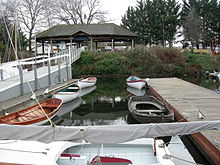
Duwamish is a retired fireboat in the United States. She is the second oldest vessel designed to fight fires in the US, after Edward M. Cotter, in Buffalo, New York.
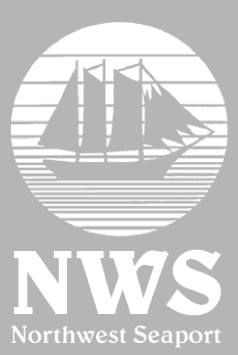
Northwest Seaport Maritime Heritage Center is a nonprofit organization in Seattle, Washington dedicated to the preservation and interpretation of Puget Sound and Northwest Coast maritime heritage, expressed through educational programs and experiences available to the public aboard its ships. The organization owns three large historic vessels docked at the Historic Ships' Wharf in Seattle's Lake Union Park; the tugboat Arthur Foss (1889), Lightship 83 Swiftsure (1904), and the halibut fishing schooner Tordenskjold (1911). These vessels are used as platforms for a variety of public programs, ranging from tours and festivals to restoration workshops and vocational training.

Going-to-the-Sun Road is a scenic mountain road in the Rocky Mountains of the western United States, in Glacier National Park in Montana. The Sun Road, as it is sometimes abbreviated in National Park Service documents, is the only road that traverses the park, crossing the Continental Divide through Logan Pass at an elevation of 6,646 feet (2,026 m), which is the highest point on the road. Construction began in 1921 and was completed in 1932 with formal dedication in the following summer on July 15, 1933. Prior to the construction of the road, visitors would need to spend several days traveling through the central part of the park, an area which can now be traversed within a few hours, excluding any stops for sightseeing or construction.

Eureka is a side-wheel paddle steamboat, built in 1890, which is now preserved at the San Francisco Maritime National Historical Park in San Francisco, California. Originally named Ukiah to commemorate the railway's recent extension into the City of Ukiah, the boat was built by the San Francisco and North Pacific Railroad Company at their Tiburon yard. Eureka has been designated a National Historic Landmark and was listed in the National Register of Historic Places on April 24, 1973.
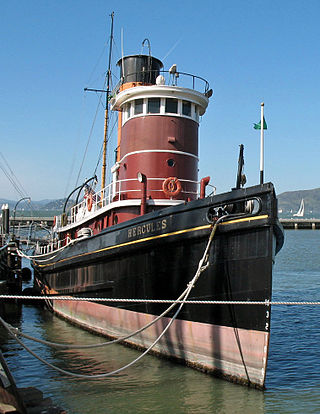
Hercules is a 1907-built steam tugboat that is now preserved at the San Francisco Maritime National Historical Park in San Francisco, California.
The Antique Boat Museum is a located in the 1000 Islands on the St. Lawrence River, in Clayton, New York, United States. The Antique Boat Museum is the premier freshwater boating museum in North America. The ABM's collections hold over 320 unique boats and thousands of related artifacts and archives. The 4.5-acre campus comes alive with speedboat rides, a working skiff livery, and educational programs. It is the site for the country's longest, continuously running annual Antique Boat Show and Auction. The museum has seasonal hours and is open from the first Friday in May to the end of October.

Wawona was an American three-masted, fore-and-aft schooner that sailed from 1897 to 1947 as a lumber carrier and fishing vessel based in Puget Sound. She was one of the last survivors of the sailing schooners in the West Coast lumber trade to San Francisco from Washington, Oregon, and Northern California.

Light Vessel Number 83 (LV-83) Swiftsure is a lightship and museum ship owned by Northwest Seaport in Seattle, Washington. Launched in 1904 at Camden, New Jersey and in active service until 1960 after serving on all five of the American west coast's lightship stations, it is the oldest surviving lightship in the United States, the only one still fitted with its original steam engine, and the last lightship with wooden decks. LV-83 was designated a National Historic Landmark in 1989, and has been undergoing major restoration since 2008.

The steamship Virginia V is one of two last operational examples of Puget Sound Mosquito Fleet steamers. She was once part of a large fleet of small passenger and freight carrying ships that linked the islands and ports of Puget Sound in Washington state in the late 19th and early 20th centuries. She is a Seattle landmark and a National Historic Landmark.

The Skagit River Hydroelectric Project is a series of dams with hydroelectric power-generating stations on the Skagit River in northern Washington State. The project is owned and operated by Seattle City Light to provide electric power for the City of Seattle and surrounding communities.
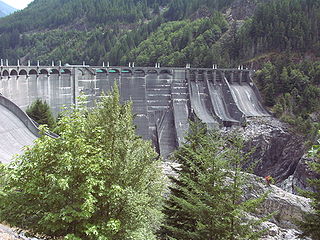
Diablo Dam is one of three dams along the upper Skagit River in Whatcom County, Washington and part of the Skagit River Hydroelectric Project that supplies Seattle with some of its power needs. The dam was built in Diablo Canyon, a gorge of solid granite with vertical walls rising 160 feet (49 m) from the river bed, yet were less than 100 feet (30 m) apart. Construction began in 1927, and was completed in 1930. The dam began generating electricity in 1936.

Keechelus Lake is a lake and reservoir in the northwest United States, near Hyak in Kittitas County, Washington. Approximately fifty miles (80 km) southeast of Seattle and a few miles southeast of Snoqualmie Pass, it is the source of the Yakima River.

The Union Stockyards of Omaha, Nebraska, were founded in 1883 in South Omaha by the Union Stock Yards Company of Omaha. A fierce rival of Chicago's Union Stock Yards, the Omaha Union Stockyards were third in the United States for production by 1890. In 1947 they were second to Chicago in the world. Omaha overtook Chicago as the nation's largest livestock market and meat packing industry center in 1955, a title which it held onto until 1971. The 116-year-old institution closed in 1999. The Livestock Exchange Building was listed on the National Register of Historic Places in 1999.
The Working Waterfront Maritime Museum is a Maritime Museum located in Tacoma, Washington, USA. The museum sits on the Thea Foss Waterway. Along with the Discovery Wharf Children's Activity Area, the WWMM is a part of the Foss Waterway Seaport, a 501c3 non-profit organization founded in 1996. In conjunction with the Foss Waterway Development Agency, the Seaport seeks private and public funds to support its mission statement. The Working Waterfront Maritime Museum is dedicated to creating "a permanent education and activity venue on the Tacoma waterfront".

The Yosemite Valley Bridges are eight bridges in the Yosemite Valley of Yosemite National Park, most of them spanning the Merced River. Five of them were built in 1928, with the remainder built between 1921 and 1933. The bridges feature a concrete structure faced with local stone, in an elliptical or three-centered arch configuration. They are notable for their uniform character and for their conformance to tenets of the National Park Service rustic style. Design work for the seven newer bridges was by George D. Whittle of the San Francisco District Office of the U.S. Bureau of Public Roads for the National Park Service. Concrete bridges were chosen at the urging of Thomas Chalmers Vint of the Park Service, in lieu of alternative designs for steel truss bridges, or suspension bridges suggested by the park superintendent.

The Wagner Houseboat, also known as The Old Boathouse, is a historic floating home in Seattle. It is located in Lake Union at 2770 Westlake Avenue, near the Aurora Bridge. Built in 1912, it is named after Richard Wagner, who bought it in the 1950s. Wagner and his wife Colleen later founded the Center for Wooden Boats, which was based out of their houseboat.
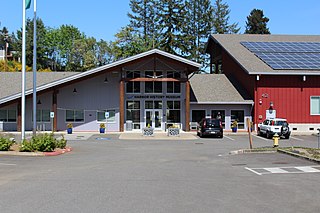
The Harbor History Museum is a regional maritime and history museum in Gig Harbor, Washington. It hosts exhibits on regional culture and history, and Midway Schoolhouse, a one-room schoolhouse built in 1893 and moved to the museum's grounds in 2009. The museum won the Washington Museum Association annual Award of Project Excellence for an ongoing living history program called Midway Pioneer School Experience that leads grade-school students through a day in an early 20th century classroom.

The Michigan Maritime Museum is a museum and research library located in South Haven in the U.S. state of Michigan. The museum is located next to the Dyckman Avenue bascule bridge on the Black River just in from Lake Michigan, the second-largest by volume of the five Great Lakes. The museum specializes in the maritime history of the state of Michigan and the lake of the same name.
The Geary 18 is an American sailboat that was designed by Ted Geary as a one-design racer and first built in 1926.

